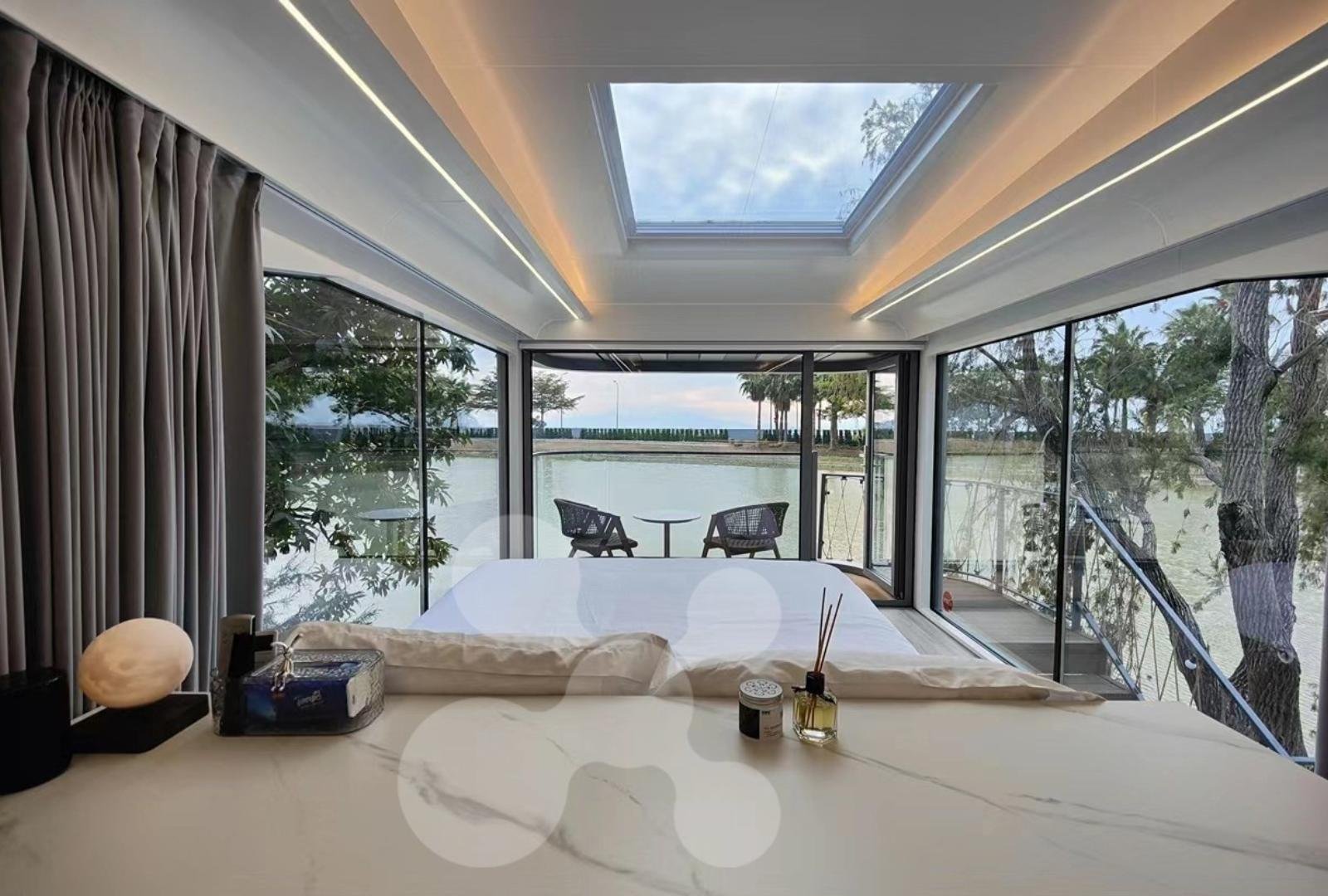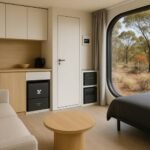Understanding Kit Homes
Let’s chat about where kit homes started and how much you’ll need to cough up to own one. Here’s hoping you find this useful when you’re on the lookout for cool kit homes for sale.
Historical Background
Kit homes have been around for quite a while—over 100 years! Between 1908 and 1940, there were over a whopping 100,000 kit homes built in the U.S. They exploded in popularity back then because they were easy on the wallet and even easier to put together. Believe it or not, Sears, the department store we all know, was a big name in this game.
These homes come in complete packages, equipped with everything you’d need and clear instructions that turn a construction challenge into an exciting project. This made owning a house possible for many families who never thought it could happen. A great choice for those looking for their own private corner of the world.

Cost Considerations
Figuring out how much these kit homes will cost you isn’t just about the upfront price tag. You’ll want to think about how they’ll affect your wallet in the long haul too. With different styles and price points, there’s something out there for everyone.
| Home Style | Ballpark Cost |
|---|---|
| Cute Cottages | $20,000 – $30,000 |
| Modern Designs | From $40,000 up |
| Studio Spaces | Prices vary |
A neat little kit home can be super inviting for newbies to the housing market or folks scouting for affordable kit homes. Plus, there are plenty of chances to spruce things up or make it your own with extras and modifications.
If you’re talking money, check out financing options for kit homes that might help make things easier for you to get your foot in the door. You could also look into steel frame kit homes or even DIY kit homes, depending on what suits your fancy.
Knowing the backstory and costs tied to kit homes can definitely steer you toward the ideal place that fits your wishes and budget perfectly.
Advantages of Kit Homes
When thinking about where you’re going to hang your hat, kit homes serve up a few tasty perks that catch the eye of singles, families, and even those big-shot business folks. Let’s dig into two biggies that make these homes stand out: the chance to put your spin on things and an easy-peasy building process.
Customisable Options
What’s super cool about kit homes? It’s that they offer a level of customisation that’s hard to beat. We get to be the boss when it comes to designing our digs, mixing and matching to suit our tastes. Whether we’re all about open spaces, hankering for an extra room, or keen on eco-friendly materials, there’s something to tickle our fancy.
| What You Can Change | What’s Involved |
|---|---|
| Layout | Pick from open spaces, add rooms, or shuffle room setups. |
| Materials | Go for timber, steel, or planet-friendly materials. |
| Finishes | Choose your flooring, cabinetry, paint colours, and fixtures. |
Building a kit home is like being handed a real-life puzzle with pieces you get to paint yourself. This way, it’s not just a place to crash; it’s our home—a piece of art that can boost its worth down the line, too.
Building Process Simplified
Putting a kit home together is a bit like following a well-trodden trail. Each piece is tagged, snipped to size, and comes with instructions that even a novice can follow. So, if we’ve only got a clue about hammering a nail, we’re still onto a winner.
When compared to those traditional house builds, prefab homes are done and dusted in a blink—akin to the time it takes to binge-watch a TV series. This speedy approach is a big win for anyone itching to settle into their comfy new home pronto.
| Building Timeline | Regular Homes | Kit Homes |
|---|---|---|
| Average Time to Build | 6-12 months | 3-6 months |
| Possible Hold-ups | Plenty | Not many |
So, not only is the building process straightforward, but it also frees us up to shape our perfect pad with creativity. For anyone looking to keep costs down, check out our pocket-friendly kit homes and see just how simple homebuilding can be. Whether you’re after compact kit homes or fancy steel frame kit homes, the sky’s the limit. Plus, for the hands-on among us, DIY kit homes let us roll up our sleeves and lay our bricks.
Types of Kit Homes
Kit homes offer all sorts of options to match what you’re looking for. We’re diving into some fan favourites: Cottage homes, Studio homes, and Contemporary designs. Each type rolls out its own flair and perks, making it easier for us to land the one that vibes with what we want.
Cottage Homes
Cottage homes hit the mark for folks craving a snug and charming place that feels straight out of a storybook. With prices tagging between $20,000 and $30,000, they’re easy on the wallet. Sporting that classic look, these homes fit right into those tranquil countryside or suburban spots.
| Feature | Specs |
|---|---|
| Price Range | $20,000 – $30,000 |
| Size | 50 – 70 sqm |
| Rooms | 1-2 Bedrooms |
They’re like a blank canvas, ready for us to splash our personality on with different layouts and finishes. It’s about crafting that little personal corner of the world.
Studio Homes
Studio homes make perfect sense if you’re flying solo or paired up and don’t need a whole lot of space. Starting as low as $10,000 for a single-room setup, they offer a comfy pad without blowing the budget.
| Feature | Specs |
|---|---|
| Starting Price | $10,000 |
| Size | 25 – 50 sqm |
| Best For | Singles or Couples |
With their open-plan style, it’s a breeze to keep things neat. Plus, we can throw in extras like kitchenettes, bathrooms, and storage spaces to tailor it just right for us.
Contemporary Designs
If a sleek, modern look is more your jam, check out contemporary designs, sitting around $40,000 to start. These homes boast sharp lines and lots of glass for that airy, spacious vibe.
| Feature | Specs |
|---|---|
| Starting Price | $40,000 |
| Size | 80 – 150 sqm |
| Style | Modern and Sleek |
Contemporary kit homes bend and flex to fit different layouts, great for families or anyone wanting more room. With an array of custom options, we can go green or high-tech, aligning with our lifestyle wishes.
Once we dive into the different kit home styles, it’s a breeze finding one that ticks all our boxes. With a lineup from affordable kit homes to steel frame kit homes, we’re sure to spot a fit, nailing that snug and personal living space.

Sustainable Features of Kit Homes
When folks dive into the eco-friendly side of kit homes, it pops out that these setups aren’t just priced right—they’re built tough and have Mother Earth in mind.
Durability and Longevity
Kit homes are in it for the long haul, sticking around for 50-plus years if we show them some love. Their sturdiness comes from top-notch materials and the precision of factory whizzes. Unlike the old-school stick-built houses, their get-up is solid and doesn’t need patching up often.
The lifespan of these homes gets a boost from timely maintenance and renovations. With a touch of modular magic, these homes hit those high standards. They stand tall and strong, asking less from us when it comes to replacing or jazzing them up.
| Feature | Kit Homes | Site-Built Homes |
|---|---|---|
| Lifespan | Over 50 years | It can vary, usually less tough |
| Construction Method | Factory-made, modular charm | Classic build |
| Defects | Minimal, thanks to the factory | More likely |
Eco-Friendly Materials
Another win for kit homes is their green thumbs. Most prefab homes wave the sustainability flag high, making smarter use of materials and cutting down on waste compared to your average build. Plus, knowing exactly what materials are needed in a factory setup means saving them from sneaky theft or damage at the site.
Homeowners have a shot to crank up their home’s green meter too. Fancy some solar panels? Or maybe an energy-efficient heat pump? Whether it’s using eco-friendly bricks or something else, options abound to make our pad greener and healthier.
We can chase down kit homes that champion these earth-friendly perks. They’re the go-to option for Australians—whether for solo living, family time, or even business needs—providing snug, private, and wallet-friendly spots to call home. Curious about crafting your eco-friendly spot? Peek at our selections in affordable kit homes, steel frame kit homes, small kit homes, and diy kit homes.
Selecting and Financing Kit Homes
Picking the perfect kit home isn’t all that hard, but it does have a few steps you need to follow. Let’s break down how to find the right plot, check out manufacturers, and sort out the cash side of things so you don’t feel like pulling your hair out.
Choosing Land
Step one in the kit home adventure is getting the right spot to plonk it down on. Here’s what we need to think about:
- Location: Make sure the land is close to places like work, schools, and shops.
- Site Preparation: Check if the place needs heaps of cleaning up or has weird bumps, as that’ll chip away at our budget.
- Zoning Rules: Double-check local rules to make sure you’re not buying a piece of land for a house you can’t build.
- Utilities: Figure out if hooking up to water, power, and septic will cost your right arm.
Here’s a quick rundown of what the wallet hit might look like just to get started:
| Thing | Estimated Cost |
|---|---|
| Land | $20,000 – $100,000 |
| Clearing the Site | $1,500 – $5,000 |
| Utility Hookups | $2,000 – $10,000 |
Researching Manufacturers
Next up, we dive into the world of kit home makers. Picking a solid one means fewer headaches down the road. Here’s our checklist:
- Experience and Reviews: Go with brands that have been around the block a few times and got thumbs up on social media or home forums.
- Product Range: Some makers provide a wide range of styles, from compact little numbers to budget or fancy custom options. Find one that suits our vibe.
- Extras: Do they throw in extras like installation or solid customer support? That’s handy.
Making a side-by-side list of different companies based on their kit offerings and how happy their customers are can save us a huge hangover later.
Financing Options
Financing is where things get real. Most kit home builders won’t hold your hand there, so we’ve got to be proactive. A quick overview of the money side of things:
- Construction Loans: These short-termloanss fund the actual building. After you’re done, switch it to a regular mortgage.
- Lenders: Rocket Mortgage and others might help with modular home funding. But with kit homes, we might have to look a bit harder.
- Budgeting: Remember, the kit’s only about a quarter of the whole cost once you chuck in labor. Keep an eye on the budget to avoid nasty surprises.
| Financing Type | Breakdown |
|---|---|
| Construction Loan | Covers building, short-term |
| Regular Mortgage | Longer-term, after the construction is done |
By dealing smartly with land choices, kit home brands, and how to fund it all, we can march into our kit home build without a hitch. For anyone keen on getting their hands dirty, checking out diy kit homes could be the go.
Warranty and Sustainability
Warranty Information
When you’re eyeing kit homes for sale, it’s a good move to check out the warranties that the manufacturers throw in. Many kit home folks offer warranties that can stretch up to 10 years for prefab homes, though the fine print can vary. Usually, this warranty has your back on structural defects and builder duties, keeping us chill while we pour our investment into a future crib. Here’s a quick peek at the usual warranty spreads:
| Warranty Type | Duration |
|---|---|
| Structural Warranty | 10 years |
| Workmanship Warranty | 1-5 years |
| Appliance Warranty | 1-2 years |
These warranties let us breathe a sigh of relief that our investment is cosy and set to last.
Green Housing Options
Why are kit homes so damn cool? They’re a big leap forward in eco-friendliness. These bad boys use green materials, which helps out Mother Earth, and they’re built to stand the test of time, often clocking in over 50 years. Check out what makes them sustainable champs:
| Feature | Benefits |
|---|---|
| Eco-Friendly Materials | Cuts down the carbon footprint |
| Solar Panel Ready | Taps into renewable energy |
| Energy-Savvy HVAC Systems | Slash energy bills |
Wanna soup up your kit home’s green cred? Think about slapping on solar panels or adding energy-smart heating and cooling units. These tweaks not only bolster the planet but also help us pinch some pennies in the long run. If you’re the hands-on type, DIY kit homes can shave costs while letting us flex our creative muscles in building a personal eco-sanctuary.
As we dive into this kit home adventure, it’s crystal clear that with the right game plan, we’re building budget-friendly, earth-loving spaces that tick all our boxes. Those seeking small kit homes or steel frame kit homes will find loads of options that’ll last and tread lightly, nudging us toward that ideal home sweet home.






